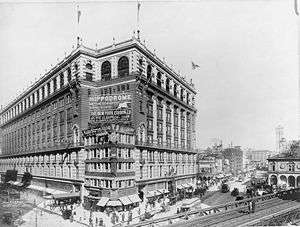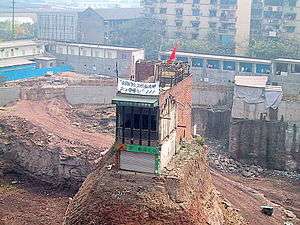Holdout (real estate)

A holdout is a piece of property that did not become part of a larger real estate development because the owner either refused to sell or wanted more than the developer would pay. There are many examples of hold-outs in the United States, the United Kingdom, Germany, China, Japan, and other countries.[1]
Examples

Macy's department store in New York City, for example, does not cover the whole block because of a holdout named the Million Dollar Corner on the corner of Broadway and W 34th Street. Now decorated as a Macy's shopping bag, the building is a holdout from the construction of Macy's Herald Square, and received its name from the fact that it sold for a million dollars in 1911, an unprecedented sum at the time.
Similarly, 30 Rockefeller Center, also in New York, has slight setbacks at its corners of 49th and 50th streets on 6th Avenue due to two buildings at those corners. The owner of 1258 6th Avenue, John F. Maxwell, grandson of the original owner, outright refused to sell to John D. Rockefeller during his land grab for construction of the complex, whereas, while Rockefeller was successful in purchasing the townhouse at 1240 6th Avenue, the lessees, who had signed a long-term lease, refused to vacate unless they were bought out to their asking sum of $250 million (equivalent to $3.9 billion in 2016).[2]
In Whitechapel, in the East End of London, the construction of the department store Wickhams, completed in 1927, on the north side of the Mile End Road was obstructed by the Spiegelhalter brothers who owned and ran a jewellers at no. 81. The store building was completed around the jewellers shop.[3]
The construction of new runway capacity at Narita International Airport in Japan starting in the 1990s was met with significant local protest; in one example, families refused to move even as the original and subsequent runway construction projects began around them.[4]
Property law

In the United States, private property is protected by the Fifth Amendment to the Constitution from seizure by the government without "just compensation". Under the concept of eminent domain, local and national government agencies are entitled to take private property for purposes in the public interest, but must offer owners compensation amounting to the value of the property. The United Kingdom, New Zealand, and the Republic of Ireland have a comparable process called compulsory purchase, and there are equivalent laws in Australia and South Africa. In Kelo v. City of New London, the United States Supreme Court held that the government is entitled to take land from private parties for any reason, including to give to private developers. The decision was widely unpopular, and spurred various states to enact laws prohibiting the practice, restricting eminent domain seizures to public works projects. However, the practice is common in other states.[5] The efforts generally begin with an offer by the private group or government agency to purchase the land, and only become a question of eminent domain if the parties cannot negotiate a purchase price.
When eminent domain seizures do occur there are often disputes over the value of the property, and whether it should fully compensate the landowner for the holdout value of the land. A historical example of a San Francisco nail house resulted in railroad investor Charles Crocker building a spite fence around a house owned by undertaker Nicolas Yung in the late 1870s, after Yung refused to sell his small property to Crocker, who was consolidating lots on which to build a mansion. Other contemporary examples include Edith Macefield, who refused to sell her Seattle house to a developer, and Randal Acker who challenged the power of eminent domain in Portland, Oregon.
The People's Republic of China passed its first modern private property law in March 2007 amid the property development bubble.[6][7]
Nail house
| Nail house | |||||||
|
Nail house in Chongqing | |||||||
| Traditional Chinese | 釘子戶 | ||||||
|---|---|---|---|---|---|---|---|
| Simplified Chinese | 钉子户 | ||||||
| |||||||
A nail house is a Chinese neologism for homes belonging to people (sometimes called "stubborn nails") who refuse to make room for real estate development. The term, a pun coined by developers, refers to nails that are stuck in wood, and cannot be pounded down with a hammer.[8][9]
Historical background
In the People's Republic of China, during most of the Communist era, private ownership of real property was abolished. The central government officially owned all real estate, and could in theory dictate who was entitled to control any piece of property according to national interests. Private citizens, therefore, did not have a legal right to keep their property if the government decided they should leave (although in practice, entitlements arose for various reasons). With a strengthening economy and the rise of free markets beginning in the late 1990s, private developers began building shopping malls, hotels, and other private developments in densely populated urban centers, which required displacing residents who lived on the land. Developers would typically offer relatively low compensation to the residents, reflecting the pre-development value of their properties or the cost of obtaining alternative housing elsewhere. Should residents resist, or try to take advantage of their bargaining position, powerful developers could persuade local officials and courts to order residents off the land. In other cases, residents would be arrested on false charges or thugs would be hired to scare away the residents.[8][10]
More recently, the People's Republic of China has begun to accept private ownership of real estate, including the still-controversial notion that owners are free to earn money when their land becomes more valuable due to planned developments, or even simply not to sell. Discontent arose among the people over accusations of illegal land seizures by developers and corruption by complicit government officials.[11]
In March 2007, the People's Republic of China passed its first modern private property law.[6] The law prohibits government taking of land, except when it is in the public interest. The law strengthened the position of nail house owners, but did not entirely resolve whether making room for private commercial developments was a public interest that entitled the taking of land.[12]
Examples
.jpg)
A number of high-profile nail houses have received widespread attention in the Chinese press. In one case in 2007, one family among 280 others at the location of a six-story shopping mall under construction at the location of a former "snack street" in Chongqing refused for two years to vacate a home their family had inhabited for three generations.[7] Developers cut their power and water, and excavated a 10-meter deep pit around their home.[8][13] The owners broke into the construction site, reoccupied it, and flew a Chinese flag on top. Yang Wu, a local martial arts champion, used nunchakus to make a staircase to their house, and threatened to beat any authorities who attempted to evict him.[8] His wife, a restaurateur named Wu Ping who had planned to open a restaurant in the home's ground floor, granted interviews and frequent press releases to generate publicity.[9] The owners turned down an offer of 3.5 million yuan (US $453,000), but eventually settled with the developers in 2007.[7]
In another example, a nail house remained in Changsha, even after a shopping mall was built around it, and now sits in a courtyard of the mall.[14] One owner in Shenzhen was paid between 10 and 20 million yuan (US $1.3 million to $2.7 million) for selling a seven-story building at the site of the future 439-meter (1,440 foot) Kingkey Finance Tower, that had cost him 1 million yuan ($130,000) to build ten years before. The resident held out for months following an eviction order, and was subject to harassment and extortion attempts even after he reached a settlement.[15] Two other nail house owners held out against the Kingkey development.[16]
Another nail house became notable after it ended up in the middle of a new road in Wenling, Zhejiang Province. The elderly couple had refused to sell the property for the price offered by the government since 2001.[17] Eventually a major two-lane road to a new train station was constructed around the house. Pictures of the home went viral on the Internet and were widely published by Chinese media.[17] The property was demolished in December 2012 after the owners accepted a compensation offer worth $41,000.[18]
Media coverage
Nail houses have received an unusual degree of coverage in the Chinese press. The Chongqing incident was initially called "coolest nail house in history" by a blogger,[13] after which the incident was picked up by major media throughout China, including state-run newspapers, and became a national sensation.[10] 85% of respondents to a poll on sina.com supported the couple rather than the developers.[7] Later, however, the Chinese government forbade newspapers from reporting on the event.[10][19][20] Another blogger, vegetable vendor Zhou Shuguang, traveled by train from his home in Hunan province to cover the incident, funded by donations from his readers. Writing under the pen name "zola", Zhou interviewed the participants, as well as crowds that had gathered and others who claimed to have been evicted from their homes. He was popularly referred to as China's first "citizen journalist" although his site was blocked as well.[21] Others defied the prohibition as well, including the Chinese edition of Sports Illustrated, which worked a subtle reference of the incident into a magazine cover.[22]
In popular culture
- In early 2010 the China Film Group Corporation, China's state-run film distributor, withdrew the film Avatar from screens early. Many commentators in China drew connections between nail house evictions and depictions in the film of forced relocation of indigenous populations by a large company.[23] The Los Angeles Times reported that the decision was due to concerns that the film would trigger dissent over the country's nail house phenomenon.[24]
- The Castle (1997 Australian film) depicts a family unwilling to accept compulsory purchase of their Melbourne home, which is near an airport runway.
- At the end of the film Batteries Not Included, the elderly couple's home remains standing and the developer is forced to construct his skyscraper around it.
- An online flash game developed by Mirage Games, The Big Battle: Nail House Versus Demolition Team, became popular in China in 2010.[25][26]
- The 1950 eminent domain-spoofing cartoon Homeless Hare involves Bugs Bunny's refusal to vacate his burrow for a skyscraper under construction. The theme would be repeated, this time for highway construction, in the 1954 Bugs Bunny short No Parking Hare.
- The 1974 film Herbie Rides Again features a firehouse being menaced by an aggressive developer who wants to put a 130-story building in its area.
- Up, a film by Pixar, features a retired widower who is threatened with being forced out of his holdout house.
- In Harry the Hairy-Nosed Wombat, published in 1970 by Jill Morris, a contest develops between Harry and road-makers in which Harry's home is repeatedly destroyed by the new road and reinstated by Harry. The stalemate is resolved by the road-builders creating a kink in the road, leaving the burrow finally unscathed.[27]
See also
- Michael Forbes (farmer)
- Narita International Airport
- Real estate in China
- Spite house
- St. Joseph Catholic Church (San Antonio, Texas)
- Vera Coking
References
- ↑ Craze, Kirsten (9 November 2015). "The real estate deals where money could not buy happiness". Home. news.com.au. Retrieved 11 August 2016.
- ↑ Miller, Tom (28 November 2012). "Rockefeller Center's David vs. Goliath -- No. 1240 6th Avenue". Daytonian in Manhattan. Retrieved 12 August 2016.
- ↑ "Wickhams Department Store, Mile End Road, East London, UK". Rick Edmondson's Unfinished Buildings. Retrieved 3 June 2012.
- ↑ "Nail households in Japan delay Narita Airport construction more than ten years". CCTV. 4 April 2007. Retrieved 13 November 2007.
- ↑ "Public Power, Private Gain". Institute of Justice. June 2003. Retrieved 2 June 2011.
- 1 2 Wu Zhong (14 May 2007). "China's rough ideological transition". Asia Times. Retrieved 12 November 2007.
- 1 2 3 4 "Nail house in Chongqing demolished". China Daily. 3 April 2007. Retrieved 13 November 2007.
- 1 2 3 4 Kent Ewing (31 March 2007). "The coolest nail house in history". Asia Times. Retrieved 12 November 2007.
- 1 2 Clifford Coonan (31 March 2007). "A Chinese man's home is his castle: kung fu master keeps bailiffs at bay in the siege of Chongqing". The Independent. London. Retrieved 13 November 2007.
- 1 2 3 French, Howard W. (26 March 2007). "In China, Fight Over Development Creates a Star". New York Times. Retrieved 13 November 2007.
- ↑ "Woman defies Chinese developers". BBC. 23 March 2007.
- ↑ Zhang Rui (23 March 2007). "First Test Case for Newly Approved Property Law?". China.org. Retrieved 13 November 2007.
- 1 2 Jeremy Goldkorn (22 March 2007). "Property rights: the coolest nail house in history". Danwei. Retrieved 12 November 2007.
- ↑ "Day In Pictures". San Francisco Chronicle. 13 November 2007. Archived from the original on May 25, 2011. Retrieved 13 November 2007.
- ↑ "Nail house owner receives millions of yuan in compensation". China Daily. 30 September 2007. Retrieved 13 November 2007.
- ↑ Catherine Jiang (2 November 2007). "Chinese homeowners nail down their rights". Asia Times. Retrieved 13 November 2007.
- 1 2 "'Nail House' Couple Refuses to Move". South China Morning Post. November 23, 2012.
- ↑ "China home marooned in middle of road is bulldozed". BBC News. 1 December 2012.
- ↑ Xiao Qiang (24 March 2007). "Chinese Government Forbids Media Reporting of The "Nailhouse" Story". China Digital Times. Archived from the original on 3 February 2008. Retrieved 13 November 2007.
- ↑ Geoffrey York (26 March 2007). "Nail house tests China's new property rights law". Scripps News. Retrieved 13 November 2007.
- ↑ "Interview with "citizen reporter" Zhou Shuguang, aka Zola". Interfax. 22 June 2007. Retrieved 13 November 2007.
- ↑ Jonathan Ansfield (12 June 2009). "Sports Illustrated Nods At The Nailhouse". Retrieved 13 November 2007.
- ↑ ""Avatar" a eulogy for China's "nail houses"". CCTV. 14 January 2010.
- ↑ Tartaglione, Nancy (19 January 2010). "China Film Group Pulling 'Avatar' From 2-D Screens Earlier Than Expected". Hollywood.com. Archived from the original on 2010-03-23.
- ↑ "Chinese hooked on 'nail house' forced relocation game". The Guardian, Beijing. 18 September 2010.
- ↑ "Plight of China's 'nail houses' reflected in online game". The Independent. UK. 21 September 2010.
- ↑ http://www.worldcat.org/title/harry-the-hairy-nosed-wombat/oclc/15795537
Further reading
- Alpern, Andrew; Durst, Seymour (1997), New York's Architectural Holdouts, ISBN 978-0-486-29425-4
External links
| Wikimedia Commons has media related to Holdout (architecture). |
- http://www.nypl.org/locations/tid/45/node/133855?lref=45%2Fcalendar
- http://ephemeralnewyork.wordpress.com/tag/holdout-buildings/
- http://www.godine.com/isbn.asp?isbn=9781567924435
- http://daytoninmanhattan.blogspot.com/2011/12/remarkabe-hold-out-at-no-249-west-end.html
- http://dornob.com/small-hold-out-nail-houses-versus-huge-developers/
- Holdouts! Reference Files, Creator: Andrew Alpern Held in the Dept. of Drawings & Archives, Avery Architectural & Fine Arts Library, Columbia University, New York City
